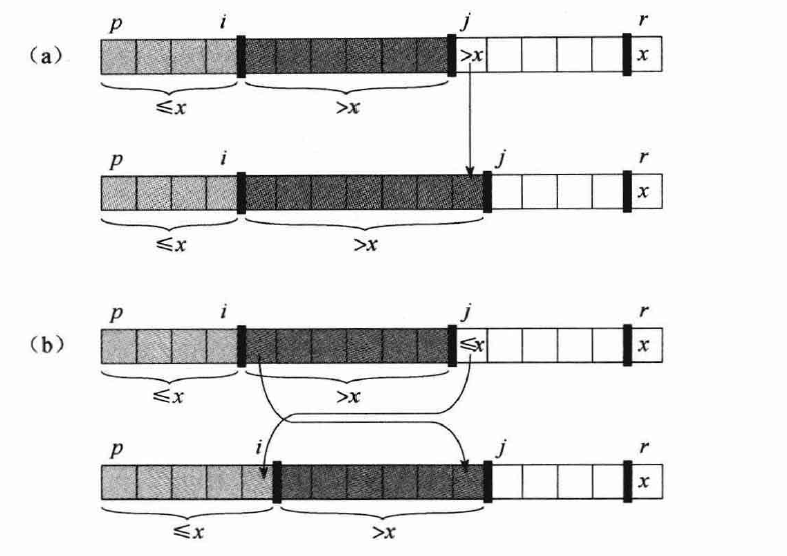快速排序
作者:互联网
快速排序能够实现原址排序,而且平均性能很好。最基本的快速排序基于分治思想。
算法过程
-
选定分界值,将原数组划分为两个部分
-
左边的值都小于分界值,右边的值都大于等于分界值
-
对左右两侧数组再次进行1、2步骤
-
直到所有数据排序完成
伪代码
QUICKSORT(A,low,high)
if low < high
q = PARTITION(A,low,high)
QUICKSORT(A,low,q-1)
QUICKSORT(A,q+1,high)
PRTITION(A,low,high)
x = A[high]
i = low-1
for j=low -> high-1
if A[j] <= x
i++
exchange A[i] with A[j]
exchange A[i+1] with A[high]
return i+1
划分(PARTITION)
-
选定一个分界值x(此例中为数组最后一个元素)
-
整个数组分为三个部分:
-
小于x的部分
-
大于等于x的部分
-
未确定的部分

-
-
循环开始时
i=low-1,j=low -
考虑当前
A[j]与分界值x的大小关系- 如果
A[j]小于x,则i++,同时交换A[i]和A[j]\(\implies\)保证i之前为小于x的值 - 否则
j++,继续遍历
- 如果
-
最后交换
A[i+1]和x
代码
void swap(int *a, int *b)
{
int temp = *a;
*a = *b;
*b = temp;
}
int partition(int *A, int low, int high)
{
int x = A[high];
int i = low - 1;
for (int j = low; j <= high - 1; j++)
{
if (A[j] <= x)
{
i++;
swap(&A[i], &A[j]);
}
}
swap(&A[i+1], &A[high]);
return i+1;
}
void quicksort(int *A, int low, int high)
{
if (low < high)
{
int q = partition(A, low, high);
quicksort(A, low, q - 1);
quicksort(A, q + 1, high);
}
}
随机化版本
输入的数组的元素分布不一定是均衡的,采用随机取样的方法期望在平均情况下划分是比较均衡的。
#include <iostream>
#include <ctime>
#include <cstdlib>
using namespace std;
//随机选择一个分界值
int random(int low, int high)
{
srand(1);
int len = high - low + 1;
return rand() % len + low;
}
void swap(int* a, int* b)
{
int temp = *a;
*a = *b;
*b = temp;
}
int partition(int* A, int low, int high)
{
int i = low - 1;
int x = A[high];
for (int j = low; j < high; j++)
{
if (A[j] <= x)
{
i++;
swap(&A[i], &A[j]);
}
}
swap(&A[i + 1], &A[high]);
return i + 1;
}
int random_partition(int* A, int low, int high)
{
int i = random(low, high);
//将分界值交换到最后一位
swap(&A[high], &A[i]);
return partition(A, low, high);
}
void random_quicksort(int* A, int low, int high)
{
if (low < high)
{
int q = random_partition(A, low, high);
random_quicksort(A, low, q - 1);
random_quicksort(A, q + 1, high);
}
}
快速排序的性能
快速排序的运行时间依赖于划分是否平衡,平衡与否依赖于划分的元素。
划分的复杂度
\[T(n)=\Theta(n)\\ n=high-low+1 \]
最坏情况分析
利用代入法证明\(T(n)=O(n^2)\)
\(T(n)=T(q)+T(n-q-1)+\Theta(n)\)
当\(q=0\)时,为最坏情况
即\(T(n)=T(0)+T(n-1)+\Theta(n)=T(n-1)+\Theta(n)\)
猜想\(T(n)=O(n^2) \to T(n)\le cn^2\)
当\(n=1\)时,成立
假设\(n=k\)时,\(T(k)=T(k-1)+\Theta(k)\le c_1k^2\)
当\(n=k+1\)时,
\(T(k+1)=T(k)+\Theta(k+1)=T(k-1)+\Theta(k)+\Theta(k-1)=T(k-1)+\Theta(k)\)
\(\therefore 存在c_2使得T(k+1)\le c_2k^2\)
\(\implies T(n)=O(n^2)\)
期望运行时间
标签:int,分界,high,low,Theta,排序,快速 来源: https://www.cnblogs.com/liyishan/p/12632526.html